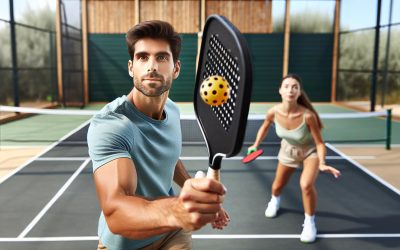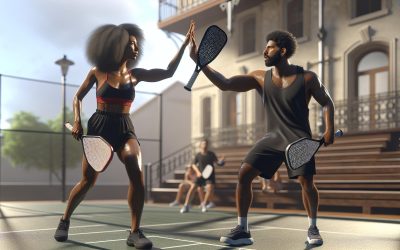When it comes to intriguing sports, pickleball has always been a bit of a puzzle to me. It’s a blend of tennis, badminton, and ping-pong, and it’s taken the sports world by storm. Yet, despite its growing popularity, many people are still scratching their heads, asking, “What’s pickleball?”
I’ve spent countless hours on the court, paddle in hand, trying to crack the pickleball puzzle. And let me tell you, it’s not just about mastering the rules or perfecting your swing. There’s a whole strategy to winning at pickleball, a method to the madness if you will.
So, if you’re as intrigued by this sport as I am, stick around. I’m about to dive into the heart of the pickleball puzzle, shedding light on its intricacies and sharing tips on how to come out on top. Whether you’re a seasoned player or a curious newbie, there’s something here for everyone.
The Blend of Tennis, Badminton, and Ping-Pong
Fascinatingly, pickleball isn’t just a stand-alone sport. Imagine mixing the techniques and aspects of three beloved racquet games – Tennis, Badminton, and Ping-Pong. You’ve got yourself a sport that’s enthralling, physical, strategic, and enjoyable all at the same time.
First off, let’s tackle the court’s setup. It’s somewhat similar to a badminton court; the dimensions, as defined by the USAPA, are 20 feet in width by 44 feet in length, divided into two equal sections by a net. It’s a notably smaller playing area compared to tennis, which means you’ll need less ground to cover. This makes pickleball a great option for those seeking a vigorous activity that comes with a lesser risk of injury.
In terms of the game’s structure, it borrows from tennis. There’s a two-out-of-three set structure, which naturally promotes a competitive atmosphere. But don’t let it fool you – scoring can be confusing at first glance. Only the serving team can score points, similar to volleyball’s system.
The most distinctive element though, is that pickleball’s gameplay is most akin to ping-pong. The perforated plastic ball, similar to a wiffle ball, is batted back and forth using solid paddles. It’s a quick game, and the challenge lies in reflexes and shot placement rather than power. This is why strategy becomes paramount.
Quick tips for beginners:
- Understand the two bounce rule. After the serve, each team must let the ball bounce once before hitting it.
- Stay out of the “kitchen”. This is a non-volley zone, and stepping into it can cost you points.
So there you have it. An exciting hybrid sport that tests your agility, hand-eye coordination, strategic thinking, and most importantly, your ability to have fun. The allure of pickleball lies in its unique blend of these racquet sports and there’s no denying its growing popularity.
Unraveling the Pickleball Puzzle
Pickleball’s blend of tennis, badminton, and ping-pong has given birth to a fascinating game with its unique scoring system and gameplay structure. This may sound complicated at first – a puzzle waiting to be solved – but let’s take a closer look.
We’ve established that Pickleball is an amalgamation of renowned racquet sports. You’re standing on a court similar to badminton, swinging a paddle instead of a racquet, over a low net just like in tennis. But there’s more to it than just merging elements of different games.
One key component that sets Pickleball apart is its peculiar “two bounce rule.” This rule states that when the ball is served, the receiving team must let it bounce once on their side of the court before returning it. Similarly, the serving team must let the return bounce once before taking their shot. This back-and-forth continues until a fault is committed.
Another distinctive aspect of pickleball is the non-volley zone, affectionately referred to as the “kitchen.” This is a seven-foot zone on both sides of the net. Players are not allowed to volley the ball from within this area. Stepping into this zone to volley can cost you valuable points; hence, it’s essential to master court positioning.
Despite these specifics, what’s pervasive about pickleball is its inherent fun and addictive nature. This game isn’t just about following rules or mimicking other sports. It’s about employing strategy, mastering hand-eye coordination, and cultivating a spirit of competition.
For beginners, I’ll always recommend getting a feel of the game first. Understand its rhythm, observe the mechanics, and practice your swings. Also, remember:
- To respect the two-bounce rule.
- Stay out of the kitchen unless the ball has bounced.
- Enjoy the game. It’s more fun than you’d expect!
As your skills and understanding of the game evolve, you’ll see the puzzle of pickleball start to unravel. It’s not just interesting and fun, it’s also a great way to stay active and meet new people. Remember, perfection comes with practice. So, keep playing, keep learning, and most importantly, enjoy the journey.
Mastering the Rules
As a seasoned pickleball player, I can’t stress enough how crucial it is to master the rules of the game. It’s like learning the alphabet before writing sentences. And let’s not forget that pickleball rules are unique, setting it apart from any other racket sports that you might’ve experienced.
You might be wondering, where do I start? It’s right at the basics: underscoring the importance of the two bounce rule and the non-volley zone. These regulations dictate the pace, strategy, and overall rhythm of the game. For optimized gameplay, they require a robust understanding.
Understanding the two bounce rule is simple. Both the serving and receiving side must let the ball bounce once before hitting it. This rule applies right from service until the point gets into full swing. From there, volleying – hitting the ball before it bounces – is allowed except in the non-volley zone.
Mastering the non-volley zone (or kitchen as it’s often referred to) is as substantial as the two bounce rule. Do you know that 7-foot area extending from the net on either side? That’s your non-volley zone. Players can’t execute a volley while standing in this region. If they do, their opponents ear a point. It’s all a part of the delicate balance of pickleball.
As players advance in their skills, they’ll start to see how these rules interplay with their strategies. For instance, strategic positioning can add pressure while maintaining the two bounce rule, forcing your opponent to stay back. Similarly, using the non-volley zone to your advantage can keep opponents away from the net, further enhancing your chances of scoring.
Pickleball isn’t just about aptly following the rules – it’s about the strategic application of these rules woven into your gameplay style. It’s about using your hand-eye coordination efficiently to swing the paddle. The idea isn’t merely to dart around the court, instead understanding and applying the rules to your advantage. Decoding the pickleball puzzle does take a bit of time and patience. But once you’ve got the hang of it, the game turns even more exciting and competitive.
Perfecting Your Swing
Just as crucial as understanding the rules in pickleball is perfecting your swing. It’s the foundation of any winning strategy. There are complexities involved in developing a smooth, consistent and effective swing. However, with regular practice and the right techniques, you can surely master this skill.
Firstly, it’s about grip. One common mistake that beginners often make is gripping the paddle too tightly. This might give a momentary sense of control, but it only leads to errant shots, not to mention added strain to your wrist and forearm. The ideal grip is firm yet relaxed, almost as if you’re holding a bird in your hand that you don’t want to fly away but also don’t want to crush.
Secondly, the swing’s efficiency relies on your stance and footwork. Footwork plays a key role in optimizing the power and accuracy of your swing. Quick, agile steps, not long, slow strides, are the secret to successful footwork in pickleball. In addition, a square stance, with your feet shoulder-width apart and parallel to the net, will give a stable base and allow for a controlled yet forceful swing.
Thirdly, strategy is involved even in the swing itself. One trick I’ve learned over the years is to mix up the speed and spin of my shots. A powerful smash is emphatically not always the best option. Sometimes a slower, strategically spun shot can be just as effective, if not more.
Finally, training and practice are irreplaceable. They say practice makes perfect and this couldn’t be truer when it comes to perfecting your swing. Time spent on the court fine-tuning your swing will certainly be reflected in your gameplay.
To sum up this part, a winning pickleball game goes beyond just understanding the rules; it involves the right techniques, strategies and, ultimately, the determination to improve. Playing pickleball is about constantly learning and enjoying the process. Equipped with a masterful swing and a comprehensive understanding of the game, the court is yours to dominate.
The Strategy to Winning
Let’s paddle into the heart of the game: creating the best strategy. You’ve mastered the rules, polished your swing, but it’s time to dive deeper. To take your game to the next level, it’s critical to explore effective strategies.
To begin, play the angles. When you’re on the court, don’t only aim for the straight shots. Mix it up. Keep your opponents guessing with a mix of straight shots and angled ones. An unexpected shot can turn the tide of the game in your favor.
Interaction is key when playing doubles. You need to utter a quick “yours” or “mine”, believe me, it saves the day more often than you think. But communication is not just about calling shots; it’s about making strategic decisions together in real-time.
One of the most important aspects of a winning strategy in pickleball is placement. Where you place the ball can make a significant difference in the outcome of the game. Utilize the entire court, and make your opponents work. Remember, the objective is to put the ball where your opponent is not.
Every player brings a different approach and style to the court. Keeping this diversity in mind, adaptability is your saving grace. It’s essential to learn, adapt and change the strategy as per the competitor’s skill set. Adapting allows you to stay ahead of the game, showcasing your dynamic skills and understanding of pickleball.
Now being armed with the right strategies, it’s about implementing them in the most suitable and effective manner. Here, your aim isn’t just to overpower your opponents but to outsmart them. Thus, constant practice and patience are crucial for your winning streak. Your ability to consistently utilize different strategies, adapt, and execute effectively, will fortify your position on the court.
The journey of mastering pickleball doesn’t end here, so stay tuned for more. Up next, we’re going to delve into various drills and exercises to help you further supercharge your game. Decoding the pickleball puzzle has more layers to it, and we will unfold each one, one by one. So, keep the excitement high as you elevate your pickleball skills and strategy to another level on this thrilling journey.
Conclusion
I’ve walked you through the ins and outs of pickleball, stressing the importance of mastering the rules and perfecting your swing. It’s clear that a winning strategy isn’t just about the swing, but also about playing angles, effective communication in doubles, and adaptable ball placement. Remember, practice makes perfect, so don’t shy away from training sessions to enhance your skills. The game’s all about strategy and adaptability, so keep these tips in mind the next time you step on the court. Stay tuned for more insights on drills and exercises that’ll take your pickleball prowess to the next level. Here’s to your future success in the exciting world of pickleball!














0 Comments